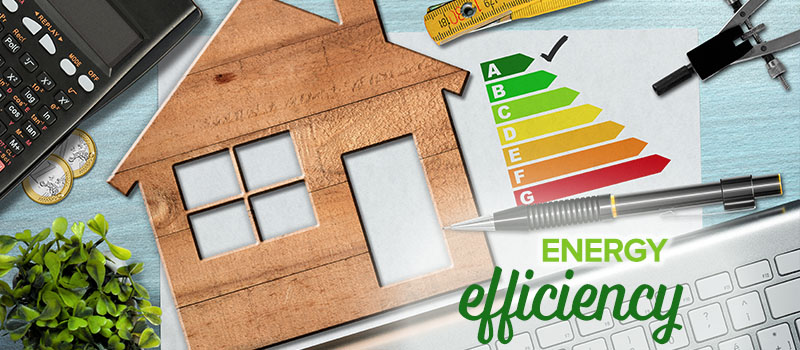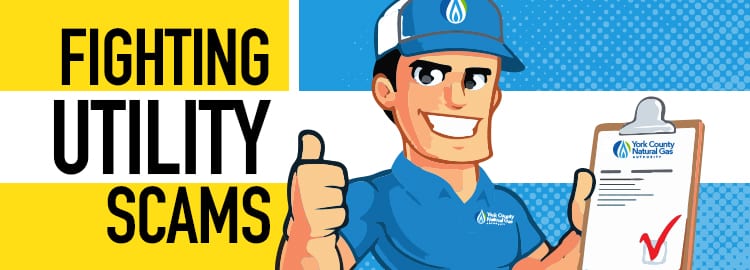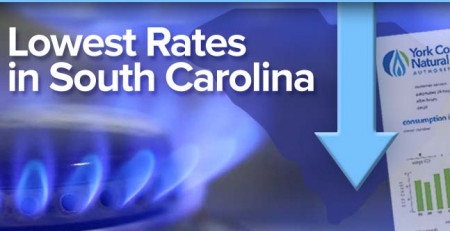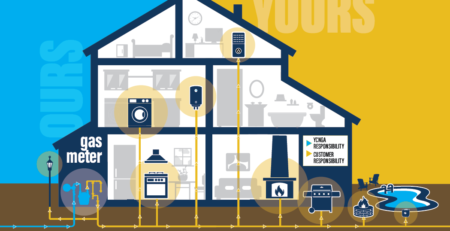Get Energetic About Efficiency
Jan 10 is National Cut Your Energy Costs Day!
When it comes to New Year’s resolutions, many make promises to reduce spending and save more every month. It turns out that your energy bill is an easy place to start. January 10th is National Cut Your Energy Costs Day, and a good reminder to make a few choices that can help save you money.
DID YOU KNOW…
DID YOU KNOW…
Natural gas is 92% efficient from site to source and cost less than electricity.
Switch to natural gas appliances for cooking, heating and water heating.
- Inspect and maintain your appliances
Older home appliances might be draining your electric or gas bill unnecessarily. Even though you’ve been putting off updating your oven/range, clothes dryer or water heater, spending money for new appliances might actually save you money in the long run.
To see for yourself, check the manual that came with your older model or look it up online to see how much energy it consumes. Then, compare it to newer models at your local appliance store. You might be surprised to find out that a new clothes dryer could pay for itself in no time!
Keep your appliances running efficiently with proper maintenance. Replacing leaky or worn-out parts as needed helps keep your system from losing energy and running up your gas bill.
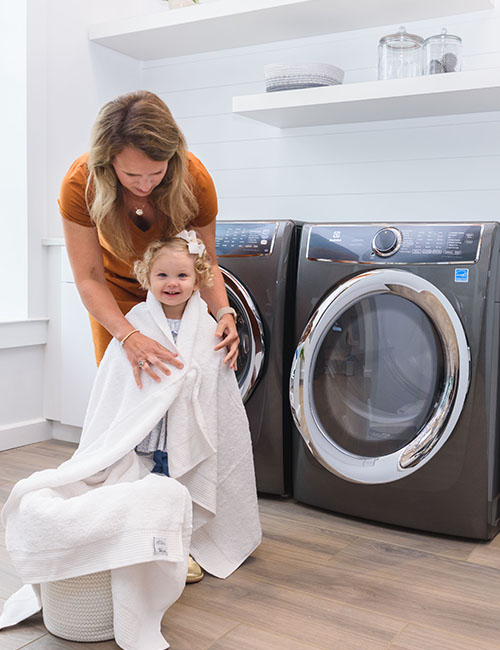
- Take Control of your Air Temperature
A central heating system works to level the temperature in your home, so with lower temperatures outside, your heating system runs more often trying to keep up. Set your thermostat to 68°F and be sure to lower it when you leave the house, or at night while you’re sleeping.
Create zones in your house, closing doors to rooms you don’t need and allowing those rooms to stay colder (in the winter) than the temperature you desire in your main living area. Close air supply registers in rooms that aren’t in use. That way, you’re only treating the air in the spaces where you’re actively spending time.
In the cooler months, take advantage of heat from the sun by opening shades and curtains for sun-facing windows. Close curtains at night or during overcast days to help insulate your home from the cold.
Install a Programmable Thermostat
Why heat an empty house when you’re not there? Invest in a programmable thermostat (for around $50 at home improvement stores) and create a schedule that follows your family’s routine. Programmable or smart wi-fi thermostats allow you to preset different schedules for times when less heating is needed.
Change Furnace Filters
Changing your furnace filter once a month during the winter is the best thing you can do to ensure your furnace operates properly. Dirty filters put stress on your furnace, increasing energy costs and potentially causing blower malfunctions.
Check Ducts and Vents for Leaks or Barriers
Check your ductwork to ensure there are no leaks. Leaking air, whether it’s hot or cold, will keep a unit working longer than necessary to reach your desired setting.
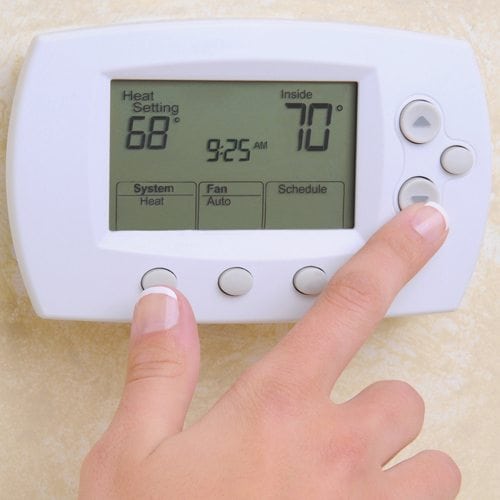
Remembering to change your thermostat every time you leave your home can be difficult. Programmable thermostats can be set to your schedule and automatically make adjustments for you.
The warm air your natural gas heating system produces should be able to flow freely throughout your home. Make sure all necessary vents are open, and assess the layout of your home to ensure no bulky furniture or appliances are blocking the vents. If air cannot flow freely, the heating system will expend precious energy trying to warm a home that stubbornly refuses to warm up. But proper airflow reduces stress on your heating system and helps lower energy expenditures.
Bundle Up
Especially in the winter, wearing extra layers helps keep your thermostat settings low and your gas bills reasonable. If you’re wearing a sweatshirt or cozy flannel pants, you may not even notice that you’ve turned the thermostat down a few degrees. And, snuggling up under extra blankets or down comforters can help keep you warm at night when your thermostat is in its energy-saving mode.
- Watch Water Usage
The average family of four uses 63 gallons of heated water per day. Water heaters are the second biggest energy users in a typical home, next to the heating and cooling system. Natural gas water heaters cost less to operate than electric water heaters, on average, and can heat water twice as fast.

To help save money on your gas bill, check the temperature setting on your water heater. The Department of Energy recommends setting a tank-based water heater to 120°F for most residential applications. If you’ve never adjusted the temperature on your water heater, it’s probably set to 140°F, which is the default setting from most manufacturers. Reducing the temperature to 120°F (or less) will save money and also prevent scalding.
Reduce your water usage by taking shorter showers and installing more efficient shower heads. And, before you start the washer, be sure you have a full load – dishes or clothes.
Go Tankless
Tankless water heaters offer even greater efficiency, as they only heat water on demand, then turn off when the demand for hot water ceases. Without a tank of water to heat and reheat, they use up to 40 percent less energy and produce an endless supply of hot water.
HOW MUCH CAN YOU SAVE?
Lowering your water temperature and insulating pipes can cut hot water costs by up to 10%. Consumers who use tankless water heaters report savings up to 30%, but costs can vary depending on hot water usage.
- Switch to a Gas Fireplace
A crackling wood fire in your hearth is a comfort in the winter, but much of the heat it generates goes straight up the chimney, while drawing cold air in through the windows and doors. This effect can cause your heating system to work harder and cost you more money. Today’s gas fireplaces offer the same captivating flames with more efficient heat. Gas logs are 99% efficient and cost only about $.35c per hour to use. The convenience of gas means no more stacking and hauling wood, no more ash to clean up, and a simple on/off switch. Instead of losing heat and energy from the draft of an open-masonry hearth, a vent-free system propels warmth into the room.
Choosing natural gas appliances is always a good decision
According to the U.S. Department of Energy, over half of all households use natural gas to heat their homes. And with good reason, too — this fossil fuel is efficient, reliable, economical and environmentally friendly. In fact, it may surprise you to learn that natural gas is actually considered the cleanest fossil fuel. It’s easy on your wallet as well, helping you save money when compared to other conventional energy sources available for residential use. According to the U.S. Department of Energy, it costs about 68 percent less than electricity per British thermal unit (Btu), the standard measure of energy.
Reducing your energy costs at home isn’t always glamorous, but it translates to real dollars being saved every month. The key is to develop a few money-saving habits around your energy usage that naturally contribute to a lower energy bill overall. From thermostat adjustments to sealing leaks, minor changes can have a significant impact on the total cost of utility bills. Update and maintain your appliances, check energy ratings, be smart about heating your home, consider switching to tankless, and you’ll be well on the way to making National Cut Your Energy Costs Day work for you and your family!
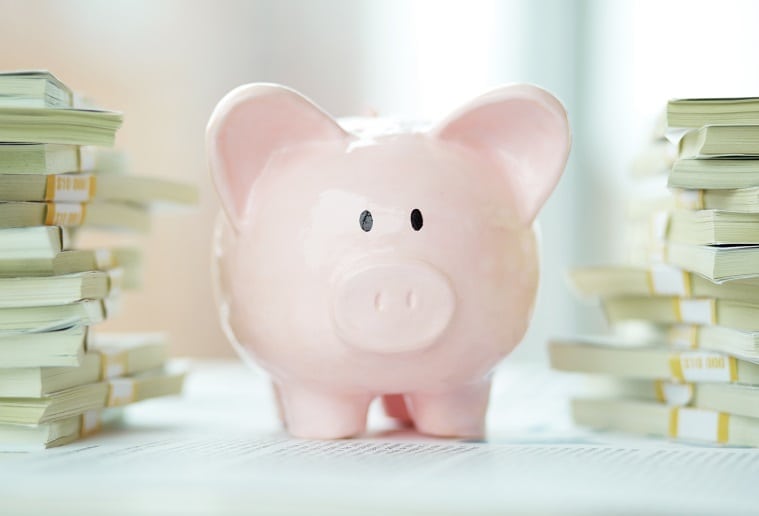
Convert & GET REBATES UP TO $925
While the initial cost of natural gas appliances may be slightly more than electric options, the long-term operating costs can be significantly lower, especially for heating, cooking, and drying clothes. To help offset the higher costs of natural gas appliances we offer energy efficiency rebates, up to $925, when you convert to natural gas from another energy source. Learn more about rebates…


